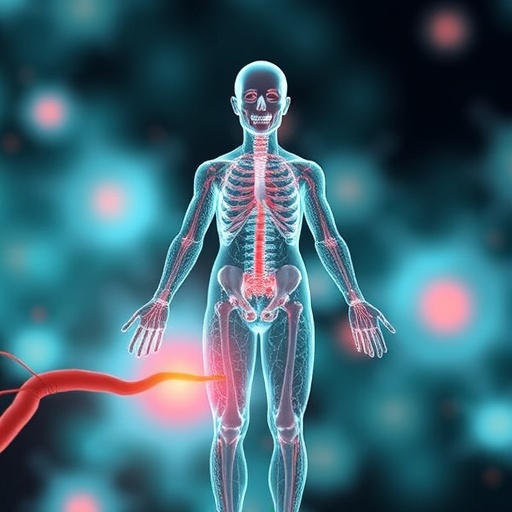Scientists at Weill Cornell Medicine have pioneered a groundbreaking technique to induce the proliferation of human endothelial cells from minimal biopsy samples, creating an unprecedented opportunity to generate vast numbers of these cells in vitro. Endothelial cells, which compose the inner lining of blood vessels, play a crucial role in regulating blood flow, immune response, and tissue repair. Historically, the ability to culture these cells in clinically meaningful quantities has been hindered by rapid senescence and loss of functionality after few divisions. This new method leverages a small molecule intervention to ‘awaken’ quiescent endothelial cells, dramatically amplifying their capacity to replicate without succumbing to aging, genetic instability, or compromised functionality.
Published in the latest issue of Nature Cardiovascular Research, this preclinical study details the transformative approach that holds promise for revolutionizing therapies targeting vascular repair, organ transplantation, and even oncological strategies aimed at dismantling aberrant tumor vasculature. The innovation enables the production of trillions of viable endothelial cells from a tiny patient sample, a feat previously deemed unattainable. This advancement could facilitate the development of vascular grafts essential for treating cardiovascular diseases, enabling new modalities for managing diabetes-induced vascular damage, and improving the viability and integration of transplanted organs.
Despite endothelial cells having been isolated and cultured since the early 1970s, their scale-up for therapeutic purposes has remained a formidable challenge. Dr. Shahin Rafii, leading the research and heading the Hartman Institute for Therapeutic Organ Regeneration at Weill Cornell, emphasized the clinical impact: “This technology allows clinical laboratories to take a small biopsy from a patient and expand it to produce over a trillion functional endothelial cells without acquiring deleterious traits.” This breakthrough offers a scalable platform that could supplant existing methods, which were limited by the cells’ propensity to become non-proliferative and dysfunctional after limited passages.
One formidable obstacle has been the inherent dormancy mechanisms within endothelial cells, tightly controlled by signaling pathways such as the aryl hydrocarbon (AH) receptor pathway. Previous research has shown that inhibition of this pathway stimulates division in hematopoietic stem cells. The team hypothesized a similar strategy might coax adult endothelial cells out of dormancy. Their experiments identified a class of small molecules capable of blocking the AH receptor’s activity, triggering exponential endothelial cell proliferation from various human tissues—particularly adult adipose tissue, accessible through minimally invasive biopsies.
Remarkably, culturing endothelial cells with AH receptor inhibitors led to a staggering expansion—up to 2 trillion cells—surpassing control cultures by two orders of magnitude. This expansion did not compromise the cells’ genetic stability or phenotypic identity; treated cells retained their endothelial markers and robust angiogenic potential. Dr. Rafii described the phenomenon as akin to a “fountain of youth,” where endothelial cells exhibit sustained replicative capacity devoid of senescence or oncogenic transformation. This finding is critical as it mitigates concerns about the safety and longevity of cultured cells intended for therapeutic implantation.
As the team delved into the underlying biology, they uncovered an unexpected mechanism of action. Contrary to their initial hypothesis, genetic knockdown of the AH receptor failed to recapitulate the proliferative effects triggered by small molecule inhibition. This indicated that the inhibitors did not simply block the canonical AH receptor signaling pathway. Further investigation revealed these molecules engage alternative pathways, modulating the receptor’s interactions with cellular proteins governing metabolism, oxidative stress, and inflammatory responses.
The inhibitors notably reduced reactive oxygen species (ROS) levels, thereby curbing oxidative damage typically associated with cellular aging. Beyond antioxidant effects, the endothelial cells shifted their metabolic profile, utilizing alternative bioenergetic pathways beyond glucose metabolism. This metabolic plasticity is believed to underpin the sustained proliferation while preserving genomic integrity. Intriguingly, the study identified an upregulation of polyamine biosynthesis, a key process supporting cellular growth and survival. Activation of polyamine production likely acts as a pivotal driver of the endothelial cells’ renewed replicative vigor.
This revelation of a non-canonical AH receptor signaling axis holds profound implications. It refines our understanding of vascular cell biology and opens new avenues for therapeutic manipulation. By harnessing these metabolic and signaling shifts, scientists can cultivate endothelial cells at scales previously unachievable, laying the foundation for engineering functional blood vessel networks requisite for organ regeneration and repair.
Looking forward, the investigators aim to dissect the precise molecular cascades initiated by AH receptor inhibitor binding. Their goal is to elucidate how this binding reshapes the signaling landscape and metabolic machinery of endothelial cells in fine detail. Such insights will not only optimize proliferation protocols but also ensure that engineered cells integrate seamlessly into host tissues, maintaining fidelity to physiological cues in vivo.
Ultimately, this pioneering work sets the stage for revolutionary advancements in regenerative medicine. The capacity to mass-produce patient-specific endothelial cells paves the way for fabricating durable vascular grafts, improving transplant outcomes, and developing precision treatments that modify pathological angiogenesis in diseases such as cancer. The research exemplifies the transformative potential of targeting cellular dormancy and metabolism to unlock new regenerative capabilities.
This exciting discovery emerges from the Hartman Institute for Therapeutic Organ Regeneration and intersects with Weill Cornell’s broader endeavors at the Englander Institute for Precision Medicine and the Sandra and Edward Meyer Cancer Center, underscoring the interdisciplinary collaboration vital for driving innovation in biomedical science. The findings serve as a clarion call for further exploration into targeted small molecule therapies that remodel cellular behavior for clinical benefit.
Subject of Research: Human endothelial cell proliferation and regenerative medicine.
Article Title: [Not explicitly provided in the source content]
News Publication Date: October 14, [Year not explicitly stated; assumed recent based on publication date]
Web References:
- Dr. Shahin Rafii Hartman Institute for Therapeutic Organ Regeneration
- Dr. Shahin Rafii Profile: vivo.weill.cornell.edu/display/cwid-srafii
- Englander Institute for Precision Medicine: eipm.weill.cornell.edu
- Sandra and Edward Meyer Cancer Center: meyercancer.weill.cornell.edu
References: Nature Cardiovascular Research (published October 14)
Keywords: Endothelial cells, blood vessels, transplantation, receptor proteins, cell growth




